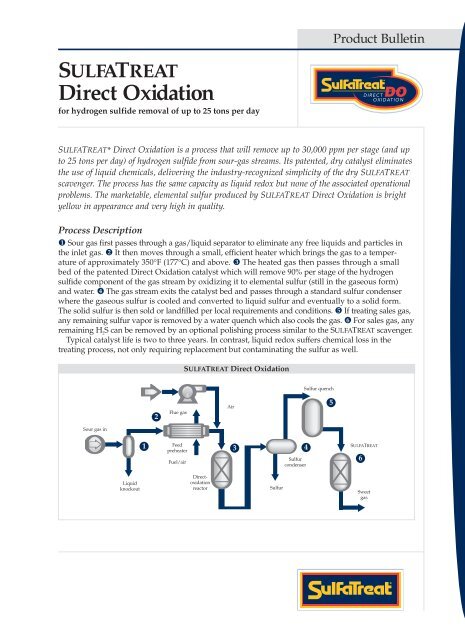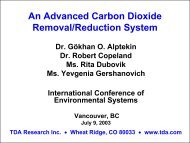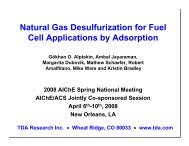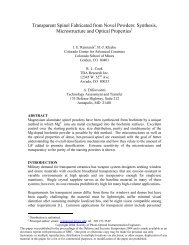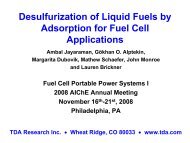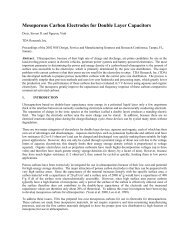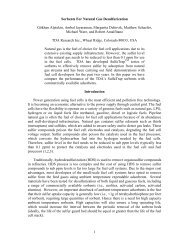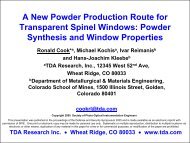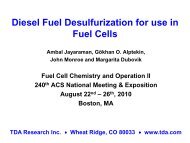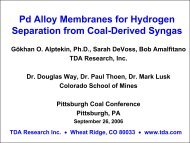SULFATREAT Direct Oxidation
SULFATREAT Direct Oxidation
SULFATREAT Direct Oxidation
Create successful ePaper yourself
Turn your PDF publications into a flip-book with our unique Google optimized e-Paper software.
Product Bulletin<strong>SULFATREAT</strong><strong>Direct</strong> <strong>Oxidation</strong>for hydrogen sulfide removal of up to 25 tons per dayDIRECTOXIDATION<strong>SULFATREAT</strong>* <strong>Direct</strong> <strong>Oxidation</strong> is a process that will remove up to 30,000 ppm per stage (and upto 25 tons per day) of hydrogen sulfide from sour-gas streams. Its patented, dry catalyst eliminatesthe use of liquid chemicals, delivering the industry-recognized simplicity of the dry <strong>SULFATREAT</strong>scavenger. The process has the same capacity as liquid redox but none of the associated operationalproblems. The marketable, elemental sulfur produced by <strong>SULFATREAT</strong> <strong>Direct</strong> <strong>Oxidation</strong> is brightyellow in appearance and very high in quality.Process Description1 Sour gas first passes through a gas/liquid separator to eliminate any free liquids and particles inthe inlet gas. 2 It then moves through a small, efficient heater which brings the gas to a temperatureof approximately 350°F (177°C) and above. 3 The heated gas then passes through a smallbed of the patented <strong>Direct</strong> <strong>Oxidation</strong> catalyst which will remove 90% per stage of the hydrogensulfide component of the gas stream by oxidizing it to elemental sulfur (still in the gaseous form)and water. 4 The gas stream exits the catalyst bed and passes through a standard sulfur condenserwhere the gaseous sulfur is cooled and converted to liquid sulfur and eventually to a solid form.The solid sulfur is then sold or landfilled per local requirements and conditions. 5 If treating sales gas,any remaining sulfur vapor is removed by a water quench which also cools the gas. 6 For sales gas, anyremaining H 2 S can be removed by an optional polishing process similar to the <strong>SULFATREAT</strong> scavenger.Typical catalyst life is two to three years. In contrast, liquid redox suffers chemical loss in thetreating process, not only requiring replacement but contaminating the sulfur as well.<strong>SULFATREAT</strong> <strong>Direct</strong> <strong>Oxidation</strong>Sulfur quench2Flue gasAir5Sour gas in1FeedpreheaterFuel/air34Sulfurcondenser<strong>SULFATREAT</strong>6Liquidknockout<strong>Direct</strong>oxidationreactorSulfurSweetgas
Typical Physical PropertiesPhysical appearance . . . . . . . . . Extrudates, white to gray in colorOdor . . . . . . . . . . . . . . . . . . . . . . . . . . . . . . . . . . . . . . . . . . . . . . . . NoneSpecific gravity . . . . . . . . . . . . . . . . . . . . . . . . . . . . . . . . . . . . 0.6 to 1.2Advantages• Non-toxic catalyst• Elemental sulfur in gas phase• No liquid chemicals• High-quality sulfur produced• Spent catalyst can be disposed of as an essentiallynon-hazardous waste subject to state, local and federalguidelines. Spent product should be tested for contaminantsfrom the gas stream.Limitations• Oxygen content must be no more than about one-half ofthe concentration of H 2 S• 25 tons per day of sulfurThis information is supplied solely for informational purposes and M-I SWACO* makes no guaranteesor warranties, either expressed or implied, with respect to the accuracy and use of this data.All product warranties and guarantees shall be governed by the Standard Terms of Sale.©2004 M-I L.L.C. All rights reserved.*Mark of M-I L.L.C.MS-05054 ______M 2/05 Litho in U.S.A.17998 Chesterfield Airport RoadSuite 215Chesterfield, MO 63005Toll-Free: 1·800·726·7687Tel: 636·532·2211Fax: 636·532·2764www.sulfatreat.comE-mail: info@sulfatreat.com


